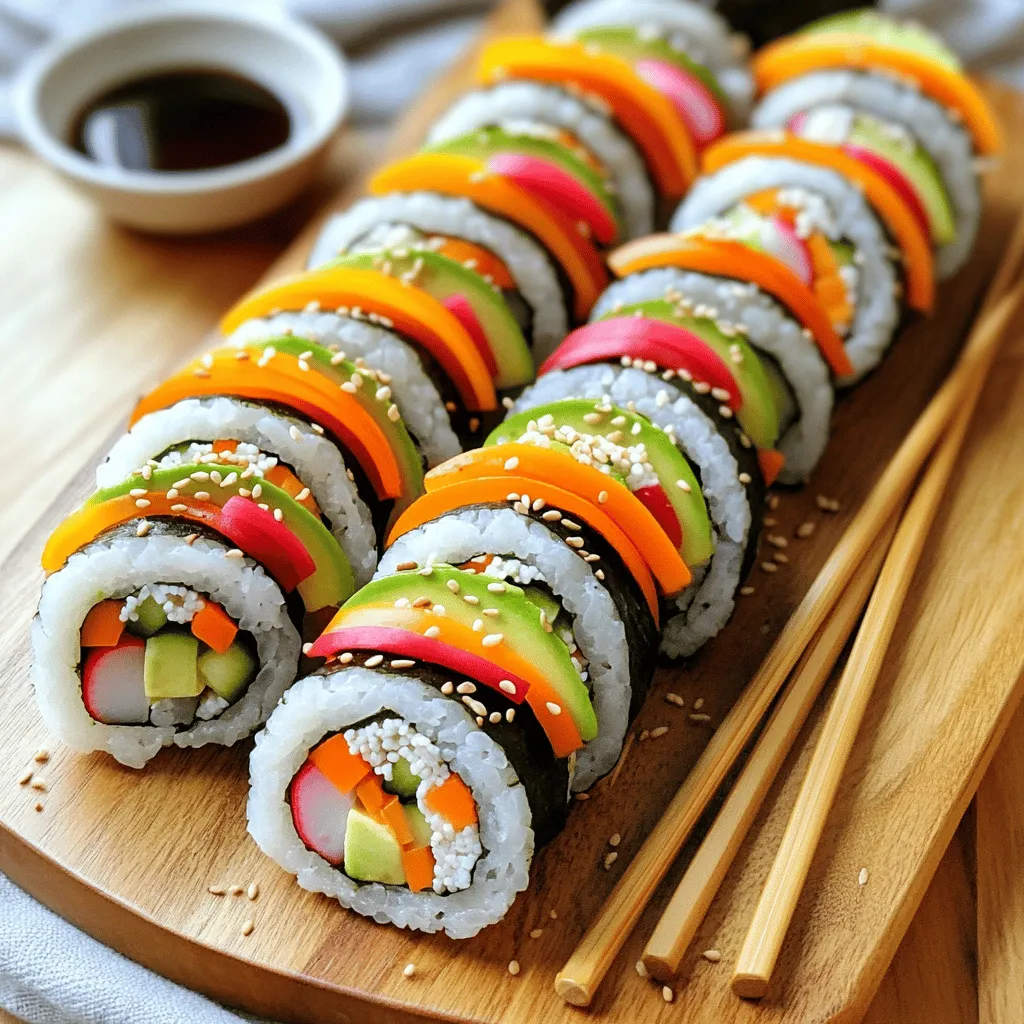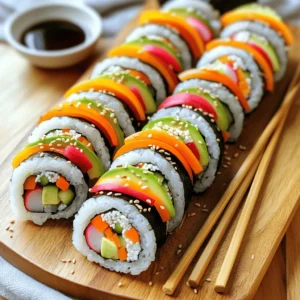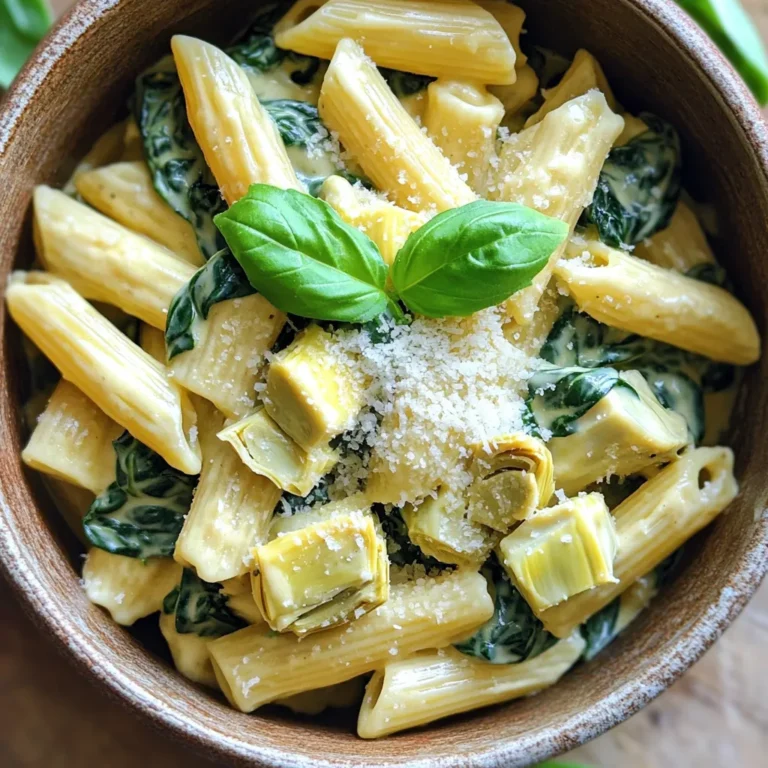Rainbow Veggie Sushi Rolls Colorful and Nutritious Bite

Looking to brighten up your meals with a splash of color and nutrition? Rainbow Veggie Sushi Rolls are a fun, tasty way to enjoy fresh veggies and healthy flavors in every bite. In this article, I’ll share how to make these vibrant rolls, the benefits of each ingredient, and tips for perfecting your sushi-making skills. Get ready to impress your friends and family with this delightful dish!
Ingredients
List of Ingredients
– 2 cups sushi rice
– 2 1/2 cups water
– 1/4 cup rice vinegar
– 1 tablespoon sugar
– 1/2 teaspoon salt
– 4 sheets nori (seaweed)
– 1 carrot, julienned
– 1 cucumber, julienned
– 1 bell pepper (red, yellow, or orange), julienned
– 1 avocado, sliced
– 1 small zucchini, julienned
– 1 radish, thinly sliced
– Sesame seeds (for garnish)
– Soy sauce (for serving)
Nutritional Benefits of Each Ingredient
Each ingredient in rainbow veggie sushi rolls adds flavor and nutrition. Here’s a closer look:
– Sushi Rice: This rice is rich in carbs, providing energy. It also has some protein.
– Nori: Seaweed is low in calories but high in vitamins and minerals, like iodine.
– Carrot: Carrots are full of beta-carotene, good for eye health. They add crunch, too.
– Cucumber: This veggie is hydrating and low in calories. It has some vitamins, too.
– Bell Pepper: Bell peppers are rich in vitamin C, boosting your immune system.
– Avocado: Avocados provide healthy fats that are good for your heart. They add creaminess.
– Zucchini: Low in calories and high in fiber, zucchini helps with digestion.
– Radish: Radishes add a peppery flavor and are low in calories. They also help with digestion.
Suggested Supplementary Ingredients
Feel free to customize your sushi rolls. Here are some tasty options:
– Tofu: Adds protein and absorbs flavors well.
– Mango: Offers a sweet and tropical twist.
– Spinach: Adds iron and a pop of color.
– Pickled Ginger: Provides zing and aids digestion.
– Sesame Oil: Drizzle for extra flavor and richness.
These ingredients can enhance your rolls and make them even more fun to eat!
Step-by-Step Instructions
Preparing the Sushi Rice
Start by rinsing the sushi rice. Use cold water until it runs clear. This helps remove extra starch. Drain the rice well. Next, place it in a rice cooker with 2 1/2 cups of water. Cook it following the rice cooker’s settings. If you don’t have a rice cooker, use a pot. Combine the rinsed rice and water. Bring it to a boil, then lower the heat. Cover and simmer for 20 minutes. After cooking, let it rest for 10 minutes to cool.
Making the Vinegar Mixture
In a small saucepan, mix rice vinegar, sugar, and salt. Heat this over low heat until the sugar and salt dissolve. Make sure it does not boil. Once mixed, set it aside to cool slightly. This mixture gives the rice a tasty kick.
Assembling and Rolling the Sushi
Lay a sheet of nori on a bamboo sushi mat. The shiny side should face down. Wet your hands so the rice does not stick. Grab about 3/4 cup of sushi rice and spread it over the nori. Leave an inch at the top edge. Next, add your veggies. In the center, make a line with julienned carrots, cucumbers, bell peppers, zucchini, radish, and avocado slices.
Now, it’s time to roll! Start at the edge nearest you. Lift the bamboo mat and roll away from yourself. Press gently but firmly to keep it tight. Roll until you reach the bare edge of the nori. Seal it with a few drops of water.
Finally, slice the sushi roll into bite-sized pieces. Use a sharp knife and wipe it between cuts for clean edges. Repeat with the remaining ingredients until all is used. Enjoy this fun making process!
Tips & Tricks
Perfecting the Rolling Technique
To roll sushi well, start with the right grip. Use your fingers to hold the bamboo mat in place. As you roll, keep the sushi tight but not too tight. This helps keep the filling inside. Lift the mat gently while rolling. Aim for a firm yet not squished roll. Practice makes perfect, so don’t worry if it’s not right the first time.
Preventing Rice from Sticking
Wet your hands before handling sushi rice. This simple step helps keep the rice from sticking to your fingers. If your rice does stick, sprinkle a little water on it. It makes it easier to spread. Always use a sharp knife when cutting the rolls. Clean the knife between cuts with a damp cloth. This way, you get nice and clean slices.
Cleaning and Slicing the Sushi Rolls
After rolling, let the sushi rest for a minute. This helps the roll hold its shape. When slicing, use a sharp knife and a gentle sawing motion. Cut through the roll without pressing down hard. If you find the knife sticking, wipe it clean. This keeps the edges neat and pretty. Enjoy slicing and serving your beautiful sushi!

Variations
Alternative Vegetables for Customization
You can swap out the veggies in your sushi rolls. This gives you room to play! Try using sweet potato, asparagus, or spinach. Each one adds a new taste and color. For a crunchy bite, radicchio or jicama also works well. Mix and match to find your favorite blend. If you want a spicy kick, add some sliced jalapeño or pickled ginger. The options are endless!
Adding Proteins or Other Fillings
If you want to add protein, consider cooked shrimp, crab, or tofu. These options make your rolls more filling. You can also try adding cream cheese or hummus for a twist. Tempeh or edamame can add a nice texture too. Just remember to balance the flavors. Keep the rolls colorful and fun!
Vegetarian and Vegan Options
Rainbow Veggie Sushi Rolls can easily be made vegetarian or vegan. All the veggies used are plant-based and nutritious. For a vegan option, just skip any dairy-like cream cheese. Use avocado and fresh herbs to keep it creamy and bright. You can also add more plant-based proteins, like chickpeas or lentils. This keeps your meal healthy and satisfying.
Storage Info
How to Store Leftover Sushi Rolls
To keep your leftover sushi rolls fresh, wrap them in plastic wrap. This keeps moisture in and prevents them from drying out. Place the wrapped rolls in an airtight container. Store them in the fridge. They can stay fresh for up to 24 hours. Sushi is best enjoyed fresh, but if you have leftovers, this method works well.
Best Practices for Reheating Sushi Rice
If you need to reheat sushi rice, use a microwave for best results. Place the rice in a bowl and sprinkle a little water over it. Cover the bowl with a damp paper towel. Heat it in 30-second bursts, stirring in between. This method helps keep the rice moist. Avoid overheating, as this can make it dry and hard.
Freezing Sushi Rolls for Later Use
You can freeze sushi rolls for later enjoyment. Wrap each roll tightly in plastic wrap. Place the wrapped rolls in a freezer-safe bag. They can be stored in the freezer for up to a month. When you’re ready to eat, let them thaw in the fridge overnight. Avoid refreezing once they are thawed, as it can affect taste and texture.
FAQs
How to make Rainbow Veggie Sushi Rolls?
To make Rainbow Veggie Sushi Rolls, start by cooking sushi rice. You need two cups of sushi rice and two and a half cups of water. Rinse the rice until the water is clear. Then, cook it in a rice cooker or on the stovetop. After cooking, mix rice vinegar, sugar, and salt in a pan until dissolved. Combine this with the warm rice. Next, lay a sheet of nori on a bamboo mat. Spread the seasoned rice on the nori, leaving the top edge bare. Add colorful veggies like carrots, cucumbers, and avocados in a line. Roll it tightly and slice into pieces.
What type of rice is best for sushi?
The best rice for sushi is sushi rice, also known as short-grain rice. This rice is sticky and holds together well. It absorbs water easily, making it perfect for sushi rolls. Avoid long-grain rice, as it does not stick and will not form rolls properly.
Can I use other types of seaweed for sushi rolls?
Yes, you can use other seaweeds like soy paper or brown rice paper. However, nori is the most common choice for sushi. It has a nice flavor and texture. Soy paper is a great alternative for those avoiding seaweed. It’s colorful and adds a unique taste.
How long do homemade sushi rolls last?
Homemade sushi rolls are best eaten fresh. They can last in the fridge for about 24 hours. After that, the rice may dry out, and the nori may become chewy. Keep them in an airtight container to maintain freshness.
What can I serve with Rainbow Veggie Sushi Rolls?
You can serve Rainbow Veggie Sushi Rolls with soy sauce for dipping. Pickled ginger and wasabi add extra flavor. Serve with a light salad or miso soup for a complete meal. Enjoy the colorful sushi with friends and family!
You learned about the key ingredients for sushi, their benefits, and how to prepare them. The steps include making sushi rice and rolling your creations perfectly. I shared tips to avoid common mistakes and ways to customize your sushi. Lastly, you now know how to store or freeze leftover rolls.
Making sushi is fun, healthy, and allows for great creativity. Enjoy crafting your rolls and sharing them with friends!







